It's happened before. It'll happen again.
Back in January 2009 Cadillac revealed the Converj concept, a two-door coupe based on the electric + gas back-up Chevrolet Volt four-door hatchback. The people who write about cars, and the people who comment on what they write, were virtually unanimous: "It's stunning, build it--just don't change the styling like you did with the Volt." Cadillac parent GM said they'd build Converj if and when they figured out how to do this profitably.
Later that year Cadillac announced that they'd decided to build the Converj, and that the styling would change very little. But soon afterwards, with GM headed towards bankruptcy and car sales plunging, the business case fell apart, and the program died...only to be revived once a post-bankruptcy GM had more cash on hand. Originally planned for 2012, Cadillac's electric coupe, now named ELR, reached dealers as a 2014 model.
And that's where most of them still are, at dealers. While many people told GM to build the car, hardly anyone has actually bought one. What happened?
To some extent, competition happened. Between the time the ELR was originally going to be launched, and the time it was launched, Tesla introduced the fully electric, much quicker, much more practical Model S and sucked up all of the cred and buzz in the room.
Then there's the matter of price. The related Chevrolet Volt initially sold for $41,000 (minus a $7,500 tax credit, which also applies to the Model S and the ELR). To spur sales, for 2014 the Volt's price was cut to $34,995. Bearing this in mind, many people expected the ELR's base price to land in the 50s, maybe even $49,995. Instead Cadillac priced the car at $75,995.
Given that the two cars share most of their mechanical bits, how much better than the Volt is the ELR? Enough to possibly justify $41,000? How about half that much?
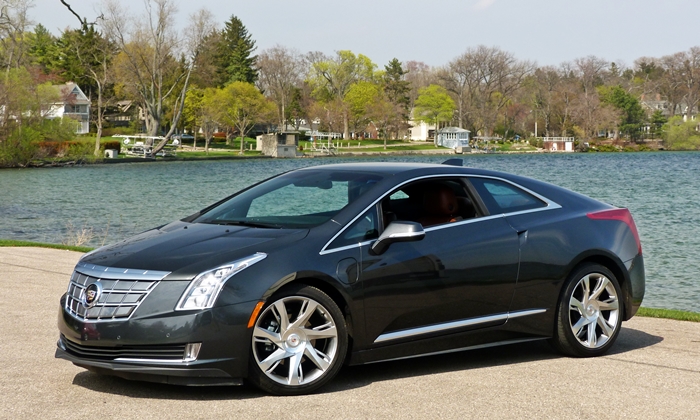
Production ELR exterior holds true to the stunning Converj concept. more ELR photos

Like other recent Cadillacs, the ELR's interior melds a dizzying number of upscale elements.
| |
Compared to the Volt |
| Exterior styling |
 Better
Worse
Better
Worse
|
Largely true to the futuristic Converj concept, the ELR is stunning. Unlike with other recent Cadillacs, the marque's angular "art and science" design language wasn't watered down a bit. Nothing else on the road, including the far more forgettable Volt, looks like it. The Cadillac CTS coupe comes closest, but has fewer angles (especially in its flanks) and, with a longer hood and more upright windshield, more conventional proportions.
The most significant change: while the Converj concept had 21-inch front wheels and 22-inch rear ones, the ELR makes do with 20s. Three inches larger in diameter than the Volt's rims, they're plenty big.
| Materials & workmanship |
 Better
Worse
Better
Worse
|
The Volt has the interior materials of a Chevrolet. Pretty good for a mainstream brand, but not upscale or luxurious. The ELR has the interior styling and materials of a Cadillac. If anything, there are too many upscale details--some buyers will wish for the simpler, cleaner interior styling of an Audi (or perhaps even the relatively spartan, not particularly well-finished cabin of a Tesla). Nearly every surface that's not wood or carbon fiber is upholstered. Synthetic suede covers the headliner and parts of the instrument panel and doors. Various enhancements add over 200 pounds, bumping the ELR's curb weight above the two-ton mark. These pounds are well spent. While the Volt doesn't seem cheap, the ELR looks, feels, and drives like a much nicer car.

Though the ELR's roof line sweeps all the way to its spoiler, it has a trunk, not a tailgate.
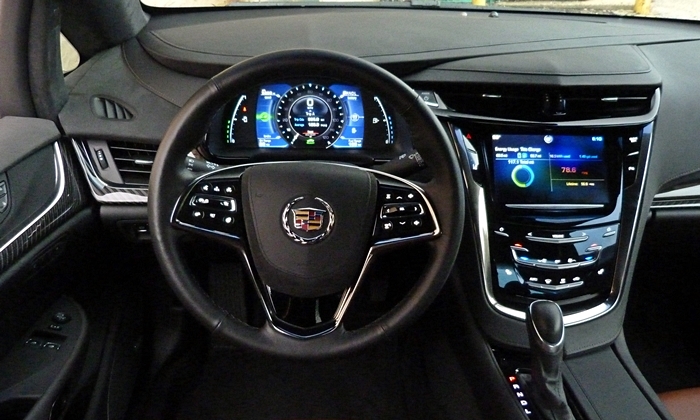
Also as in other recent Cadillac's the touch-sensitive controls can be finicky.
| Handling |
 Better
Worse
Better
Worse
|
When I first drove the Volt, I was suprised by how well it handled. But then, given Cruze-based underpinnings and additional weight in the nose, I expected it to handle badly. Instead I discovered well-controlled body motions and a willingness to turn.
Cadillac upgraded the ELR's suspension in a number of ways. Up front, GM's HiPer Struts keep the tires more square with the road surface as the car leans than the Volt's simpler MacPhersons. In back, a Watt's link has been added to more precisely control the beam axle. All four corners gain adaptive dampers, which continuously adjust to the quality of the road surface and how the car is being driven. The tires, 245/40HR20s, have much larger contact patches than the Volt's 215/55HR17s.
These upgrades work as intended. Compared to the Volt, the ELR corners with less lean and more precision. Its steering, considerably firmer than the Chevrolet's single-mode system, feels tight on center and weights up especially nicely in Sport mode (though feel remains in short supply). But press the car hard and you'll discover that, despite the Cadillac's wider tires, grip remains well short of the Tesla's (if well beyond the Volt's). Blame is likely due a higher center of gravity, a less balanced weight distribution (which overloads the front tires), and a more efficiency-oriented tread compound.
Overall, the ELR steers and handles much better than the Volt, itself a better handler than other electron-fueled front drivers. Is the Cadillac fun? Not really, at least not in any adolescent sense. But driving the ELR is nevertheless thoroughly satisfying. I enjoyed my week behind its wheel.
| Quietness |
 Better
Worse
Better
Worse
|
Some of the ELR's extra pounds went into sound insulation. Though either car's powertrain is nearly silent in electric mode, and wind noise is hushed, the Volt suffers from considerably more road noise. The ELR's tires do sing a little on concrete, and thump a touch over tar strips, but this is common among upscale cars with even modest sporting aspirations. In general the ELR has the composed, quiet ride of a luxury car.
When the gas engine kicks in to charge the battery (it only directly powers the wheels at highway speeds), it evokes a muted, distant-sounding drone. At rest you'll also feel some vibration. While the smooth silence of fully electric operation is clearly preferable, I've heard and felt much worse from the diesels in some European luxury cars. And as long as there's some charge in the battery pack there's no need to experience it.
| Front seat support & comfort |
 Better
Worse
Better
Worse
|
Both cars have comfortable front seats, but the ELR's provide more lateral support, at least with the $2,450 brown interior option (which adds power adjusters to their modestly sized side bolsters).
Front seat access isn't among the ELR's strengths. As is often the case with coupes, the doors are long and heavy.
| |
Compared to the Volt |
| Price or payments |
 Better
Worse
Better
Worse
|
The top reason not to buy an ELR is so obvious that one must wonder why it wasn't obvious to Cadillac: the only thing crazier than the $75,995 base price is the fully loaded tested car's $82,135 window sticker.
When hearing the ELR's price, you might think, "I can buy a Tesla for that." This isn't entirely fair. While the Model S starts at $71,100, it comes with far fewer standard features than the ELR. Add $13,650 of options to the Tesla, and it still has about $3,800 less content than the Cadillac, for a feature-adjusted price difference around $12,500.
How much should the ELR list for? The ELR is a much nicer car than the already nice Volt. But the Cadillac XTS is similarly nicer than the Chevrolet Impala with which it shares a powertrain and other underpinnings. In that case, the Cadillac lists for about $11,000 more than the related Chevrolet after adjusting for feature differences. Compared to the Volt, the ELR includes roughly $5,000 in additional content. Add another $1,500 for the ELR's dubs and we get a total of $17,500. The ELR is a larger upgrade over the Volt than the XTS is over the Impala. So a $20,000 bump, yielding the $54,995 base price expected by informed onlookers, might seem justified.
Search Autotrader.com, and you'll find some Cadillac dealers have begun offering the ELR for $20,000 below sticker. In related news, monthly ELR sales finally topped 100 in July.
How could GM be so far off in its initial pricing? Recall that its executives could only okay producing the Converj / ELR if it would be profitable. I suspect that the car could only be profitable, given the projected sales for a Volt less two doors, with a starting price over $75,000. They really wanted to produce the car, so they somehow convinced themselves that people would pay big big bucks for it.
The same thought process also has crimped sales of the ATS and CTS. GM has to introduce the cars at the prices used to justify their creation. And these prices are high because GM has been engineering and contenting the cars to compete with the world's best. Only after buyers refuse to bite, partly because brand reputations tend to lag product reality by years, do they then slash these prices.
| Rear seat room & comfort |
 Better
Worse
Better
Worse
|
The Volt's rear seat is pretty tight. The Cadillac ELR's is even tighter. At 5-9, I barely have enough space for my head and knees, and this when sitting behind someone my own size. Put someone taller in the front seat, and even pre-teens will have trouble squeezing into the back seat. This being a two-door, rear seat access is also dicey.
The Tesla's rear seat is far roomier than either GM car's. Plus a rear-facing third row is optional.
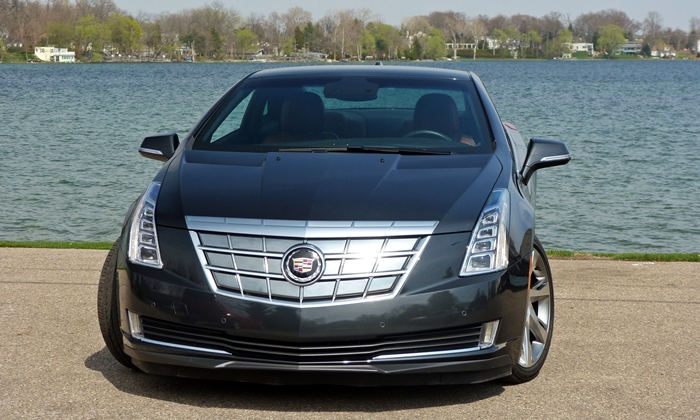
Vertical lamps (LEDs here) a Cadillac signature. Large grille largely blocked off because electric.
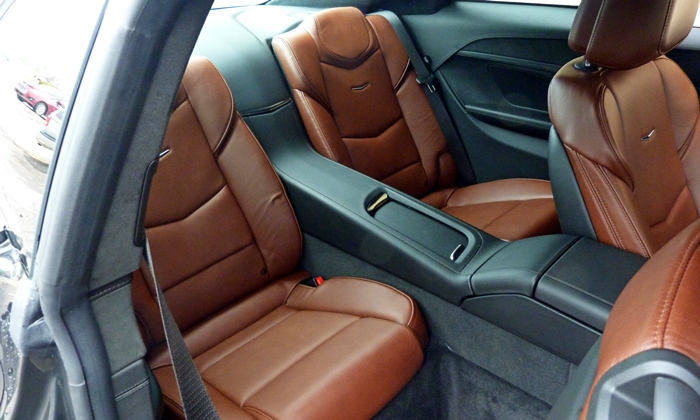
Tight and hard to get into. T-shaped battery pack resides within the high console, behind the seats.
| Driving position & visibility |
 Better
Worse
Better
Worse
|
You sit much lower in the Cadillac ELR than in the Chevrolet Volt. And the Marianas Trench has nothing on the Cadillac's vast upholstered instrument panel. So the view forward is the opposite of the open sort I personally prefer. A high tail similarly constricts the view to the rear. The Converj concept used cameras in place of rear view mirrors. The ELR instead employs small mirrors, and the one on the right is partially obstructed. I highly recommend blind zone alert, part of the $1,695 Luxury Package.
For ambiance, the cashmere interior might be the best way to go, even though this means sacrificing the brown seats' power-adjustable bolsters. Given the ELR's small windows and lack of a sunroof option, the other two interiors should include a prescription for Zoloft.
| Cargo capacity |
 Better
Worse
Better
Worse
|
While the Volt is a hatchback, the ELR is a coupe, with a trunk. Said trunk can hold a bit over ten cubic feet, which should be sufficient for two travelers, four in a literal pinch. The rear seats can be folded to expand the trunk, but a center column remains fixed in place. (Hopefully the rear seat passengers enjoy the high console that precluded a larger opening.) If you want to carry a bike inside the car, you need the Volt. Or, even better, the much larger, more efficiently packaged Tesla.
| |
Compared to the Volt |
| Powertrain performance |
 Better
Worse
Better
Worse
|
To offset the Cadillac's higher curb weight and support its more upscale position, GM squeezed 32 more horsepower out of the Volt's electric drive motor for the ELR--when the gas engine is running. (When running solely off of battery power, peak output is 157 horsepower in the ELR vs. 149 in the Volt.) There's a Hold mode to force the 86-horsepower 1.4-liter gas engine (premium fuel recommended) to remain running. While the primary reason for this mode is to save the battery for use where it most benefits fuel efficiency, in city driving, it also cuts a foot-to-the-floor run to 60 mph from about nine seconds to about eight. You can only select one mode at a time, so it's not possible to simultaneously maximize acceleration (via Hold mode) and handling (via Sport mode).
At highway speeds the gas engine can directly drive the wheels, rather than channeling all of tis power into the generator. In this case, it can combine with the electric drive motor to send as much as 217 horsepower towards the front wheels. Aside from the small amount of noise and vibration noted elsewhere in this review, transitions between the powertrain's different modes are imperceptible.
An eight-second run to 60 isn't nearly as quick as even the base Tesla, much less the 4.5-second adrenaline rush of the 416-horsepower Performance model. But, for most people nearly all of the time, the ELR is plenty quick. It helps that, as in all electric vehicles, the motor's 295 lb-ft of torque are instantly available, with virtually zero lag. As in a high-speed elevator, just one operating horizontally rather than vertically, acceleration feels strong yet eerily smooth. The difference from gas engines must be experienced to be comprehended. The upshot: the ELR feels very responsive in typical daily driving.
| Safety & braking |
 Better
Worse
Better
Worse
|
Tesla unusually engages full brake energy generation (using a generator connected to the wheels to slow the car) whenever the driver lifts off the accelerator. The brake pedal in a Model S operates only the car's conventional brakes. This gives the driver complete control over how much braking is performed by the conventional brakes, but makes it more difficult to coast.
In the Volt and ELR, as in most hybrids, in the default driving mode the car coasts when the driver lifts off the accelerator. Regeneration is engaged when the brake pedal is pressed. Since regenerative braking cannot slow the car very quickly, once the brake pedal is pressed beyond a certain point the conventional brakes are brought into play, reducing overall efficiency (since they convert the car's kinetic energy into waste heat rather than using it to recharge the battery). In early hybrids this transition from one braking system to another was pretty klunky, and braking felt odd as a result. In the Volt and ELR it's close to seamless. It's necessay to study the efficiency indicator to get a sense of how hard you can brake before the conventional system starts doing a significant amount of the work.
If you want either GM car to engage regenerative braking whenever you lift off the accelerator, like the Tesla, shift from D into L. Or, in the ELR exclusively, pull back on one of the paddles flanking the steering wheel. Doing so immediately engages full regenerative braking. This can be useful when driving the Cadillac fairly aggressively, to brake ahead of curves with a minimum impact on the car's efficiency. While much the same can be accomplished by shifting into L, you can operate the paddles more selectively, and without removing a hand from the wheel.
| Fuel economy |
 Better
Worse
Better
Worse
|
And now the reason people buy electric cars in the first place: fuel efficiency. I haven't placed fuel efficiency among the reasons to buy a Cadillac ELR because the Chevrolet Volt is about ten percent more efficient. Also, a Tesla Model S can travel much farther between charges, over 200 miles vs. 30 to 55, because it can use up to 85 kWh of electricity vs. the Volt's 10.6 and the ELR's 11.9.
GM placed a different bet than Tesla. It reasoned that many people drive less than 30 miles a day. And that providing enough battery capacity to travel much farther than this would cost much more than it would be worth to these people. For those times when more range is needed, GM fitted a gas engine that could come on to maintain a minimum level of charge in the battery. When running on gasoline, the ELR's trip computer reports about 28 mpg in the suburbs and 35 mpg on the highway. These would be okay numbers for a non-hybrid, but they aren't the sort that get people excited about alt-fuel cars.
Judging from the much higher sales of the Tesla Model S, it turns out that many people are willing to pay the extra cash for a larger battery, after all. Especially when this battery also enables better performance and, when packaged beneath the floor, a roomier interior.
Range aside, the ELR is inexpensive to operate on electricity. The 55-mile "best case" range figure for the ELR works out to 4.6 miles per kWh. Factor in charging losses (more energy comes out of the outlet than ends up in the battery) and each of these miles cost about three cents at the average price for electricity. This is much less than the 14 cents per mile when using a $4.00 gallon of gas to go 28 miles. I managed this figure during my week with the ELR via a light foot and no A/C. Going without A/C isn't easy. There's no way to turn off the A/C without turning off the climate control entirely. Instead, you can select one of three modes: min, eco, and max. Opt for max, and the A/C sucks up about 44 percent of the battery's energy. Opt for min, and this figure falls to about six percent, but the A/C then struggles to combat the solar energy radiating off the vast black instrument panel.
I appreciated how the Chevrolet Volt scored my driving. Seeking to maximize my score improved my efficiency. The ELR provides no such score. Perhaps Cadillac figured that its customers would be offended by an attempt to grade their performance (though other luxury brands do it).
A note on charging: a standard wall outlet charges the ELR's battery pack very slowly, and can take up to 16 hours to top one off. I plugged the car in when I got home in the early evening, and it was only about three-quarters full when I drove off the next morning. I was twice able to use some free public high-voltage chargers. These can get the job done in four hours, and are increasingly common in some parts of the country.
The problem with the ELR isn't that it's not a good car. Though not very practical--it's a coupe with a tight back seat, after all--its appearance, interior materials, and on-road behavior are easily worthy of the Cadillac brand. It can't travel as far on electricity as the Tesla, but most people don't often drive long distances. And the gas engine is there for those times when more range is needed.
The problem with the ELR is quite simply that Cadillac priced it far too high.
This didn't come up back in 2009 because Cadillac didn't even hint at a price for the Converj. The typical car reviewer will freely spend readers' money ("at only $50,000, this sports car is a bargain, place your order now"). But they're even more likely to predict strong sales for a sexy concept if the price is unknown.
The ELR is sexy, and its attractions are more than skin deep. If these strongly appeal to you, but the window sticker scared you away, recent deep discounts bring the price within reason. And maybe even within your budget.
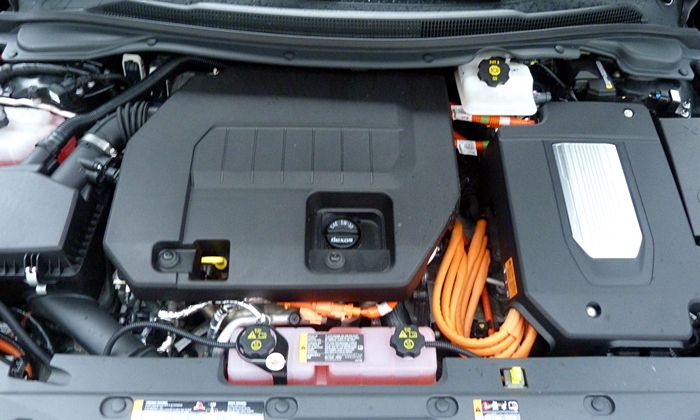
Gas engine largely serves as a back-up, but must be summoned for peak power.
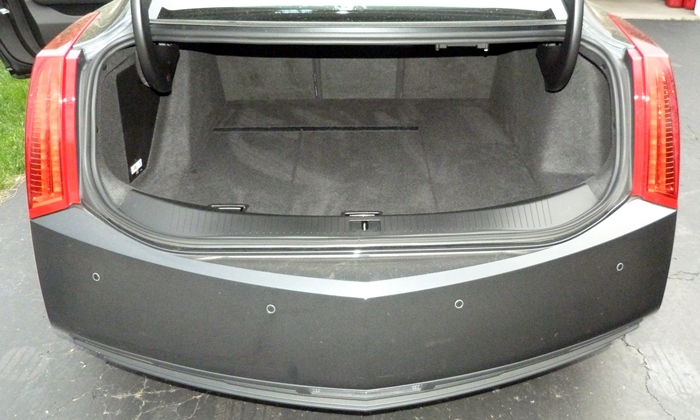
Adequate trunk space, given the typical roles of a coupe.
See more 2014 Cadillac ELR photos
Cadillac provided an insured ELR for a week with a tank of gas (of which I used little). To refresh my memory of how the Volt compares, Robert Head of Serra Chevrolet in Soutfield, MI, helpfully provided one. He can be reached at 248-354-6001.











